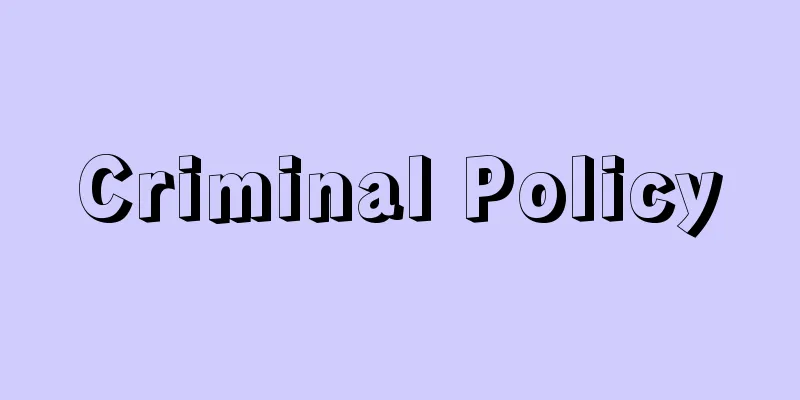Criminal Policy

|
A general term for policies implemented by national or local governments regarding crime prevention. Criminal policy theory is the academic subject of criminal policy. However, there is no consensus on the concept of criminal policy, and around 1800, when the term was first used, it referred to discussions on how punishment and the criminal law that stipulates it should be in response to new crimes that disrupt social order, in other words, criminal legislative policy and criminal policy were almost synonymous. However, from the second half of the 19th century, supported by the rapid progress of human behavioral science, the concept of criminal policy came to include various measures other than criminal law and punishment that are taken to protect society from crime and criminals. [Tetsuo Yoneyama] Criminal Policy ConceptFirst, criminal policy does not mean crime prevention in general, but rather means devising a "way" of crime prevention. Crime prevention measures themselves may be taken by the state or local governments, or by private individuals. Private individuals may take various crime prevention measures to prevent themselves or their families from becoming victims of crime, or to maintain their familiar living environment, and if these measures are unsuccessful, they may devise other measures. For example, they may lock their houses to prevent burglaries, and if they are still broken into, they may keep a dog, or they may cooperate with the neighborhood and ask the police to patrol the house, etc. It is also possible to express various opinions about general crime prevention measures, such as measures against juvenile delinquency. However, on top of such individual concrete measures, there must be principles that regulate, frame, or regulate them, and activities that devise such principles. This is criminal policy. Secondly, criminal policy is an activity carried out by the national or local government, which has the authority and responsibility to determine what acts are crimes and to establish a legal system to deal with crime. Traditionally, many volunteers have been active in the field of criminal rehabilitation. For example, both the probation system and the reformatory system were originally measures for criminals that were started voluntarily by private individuals, but were later adopted as national systems. However, the actions of private individuals cannot be called criminal policy, no matter how effective they may be in terms of crime prevention. Criminal policy involves considering how to position effective crime prevention measures and activities carried out by private individuals within national crime prevention measures. Thirdly, the crime prevention measures that criminal policy targets are those that directly aim to prevent, deter, suppress, and take measures to deal with crime. When poverty and unemployment are considered to be the causes of crime, social policies may be the best crime prevention measures, and when a decline in normative consciousness resulting from a lack of discipline becomes apparent, educational policies may be the best crime prevention measures. In addition, it may be most effective to deal with crimes caused by mental disorders through medical and welfare measures. However, these social, educational, and welfare policies cannot be called crime prevention measures immediately. The basic objectives of these policies are to secure employment, perfect the personality, and promote the happiness of the people. However, how to utilize the knowledge gained in the process of implementing these policies in crime prevention is an important issue in criminal policy. Fourth, the "crime" in the crime countermeasures targeted by criminal policy is different from the concept of crime in criminal law (illegal and culpable acts that meet the constituent elements), and refers to acts that are harmful to maintaining and realizing social order and that justify the public authority in taking some measures. For example, the acts of those who are not responsible for their own actions (juveniles under the age of 14 and those who are mentally incompetent) are not crimes under the Criminal Code because they lack the requirement of "culpability," but they are crimes under criminal policy. Also, prostitution and acts of risk of committing a crime by a juvenile are not crimes under the Criminal Code, but they are crimes under criminal policy because they are not subject to punishment. The concept of crime in criminal law is restricted by the principle of criminal legality and the principle of responsibility, but in criminal policy, a realistic concept of crime must be used that should be kept in mind when working to amend, abolish, or establish a new criminal code. [Tetsuo Yoneyama] History of criminal policyThe primitive functions of public power are said to be the elimination of foreign enemies externally and the maintenance and realization of social order internally. Criminal policy is related to the latter function. In this sense, criminal policy is as old as the birth of the state. The criminal code, said to be the oldest law in the legal system, is at the heart of a country's crime prevention measures. However, it is generally said that criminal policy is a product of the 19th century. This is because, in the 19th century, the ideological situation during the French Revolution (as expressed in the French Declaration of the Rights of Man and of the Citizen) spread throughout Europe, the social harm caused by the spread of the Industrial Revolution became evident, and human behavioral science developed dramatically, calling for a scientific, rational, and humanistic criminal policy, which came to be considered to be criminal policy. Beccaria's Crimes and Punishments, published in 1764, sharply criticized the arbitrary and harsh criminal trials and the execution of punishments at the time. In 1777, Howard's Prison Circumstances publicly described the appalling conditions of prisons in England and Wales and called for reform of the prison system. Howard's arguments were later applied to the American prison system, giving rise to the Pennsylvania system (strict solitary confinement) and the Auburn system (silence system, in which prisoners were forced to remain silent during the day while working in a multi-use factory and were detained in solitary confinement at night). The French Revolution was a historical turning point that should have brought about fundamental reform of the criminal law system. In response to this situation, Anselm Feuerbach emphasized general prevention through the threat of punishment (psychological coercion theory) rather than general prevention through the execution of punishment, particularly public executions, which incites fear (preventing ordinary people from committing crimes), and provided a theoretical foundation for the principle of criminal legality. In the first half of the 19th century, special prevention against individual criminals (preventing certain criminals from committing crimes again) was not ignored, but rather interest was directed toward restricting the state's right to punish, and there was a demand for criminal law that could guarantee the protection of human rights through proportionality of crimes and punishments and the determination of crimes and punishments. However, in the second half of the 19th century, especially after the 1870s, on the one hand, liberal criminal law reached a state of perfection (application of the death penalty for minor crimes was hesitant), and on the other hand, the drawbacks of early capitalism brought about by the Industrial Revolution became apparent, and industrial society became plagued by recidivism, mainly for property crimes. The previous premise that crime is an act based on the free will of rational human beings and that punishment is the embodiment of moral condemnation was no longer useful for solving this recidivism phenomenon. Instead, the idea that crime is a phenomenon causally determined by the qualities and upbringing of each individual person, and that its causes should be scientifically elucidated and that rational crime prevention measures appropriate to each individual should be taken. The scientific elucidation of crime had been carried out by Quetelet and André Michel Guerry (1802-1866) using statistical methods since the first half of the 19th century, but in 1876, the Italian Lombroso wrote "De Criminal" in which he claimed that "criminals in civilized society are atavistic people who, due to poor heredity, remain in an earlier state in the history of human development," and named these people "born criminals." His claim was later forced to change under the pressure of Enrico Ferri (1856-1929) and Alexandre Lacassagne (1843-1924), who emphasized social and environmental factors over individual factors, but his empirical scientific method of deriving hypotheses by measuring the skulls and body shapes of 3,000 prisoners and soldiers left a significant mark on the study of crime. In Germany, Franz von List, in his book "Teleological Thoughts in the Criminal Law" (1882), argued that punishment was a means of defending society, and classified criminals into three groups: reformable, in reformable, and those for whom reform measures were not necessary, and argued that reformatory punishment, isolation (ostracism) punishment, and intimidation punishment should be imposed on each group. List's idea of objective punishment became the core of the new school of criminal law, and sparked a spectacular debate between the new school and the classical school (the old school). However, from the end of the 19th century to the 20th century, as a compromise between the old and new schools, criminal laws were enacted that adopted a dualism between punishment for those who are responsible and security measures for those who are not responsible. The forerunner of this was Carl Stooss's (1849-1934) Preliminary Draft of the Swiss Criminal Code (1893). In addition, Ferri's Draft of the Italian Criminal Code (1921) adopted a monistic principle of social defense measures, which had a great influence on criminal legislation in the Soviet Union and South American countries at the time. After World War II, the theory of social defense was developed into a new theory of social defense, which calls for the guarantee of freedom and basic human rights through legalism, the establishment of a scientific criminal treatment system, due consideration for general prevention, and a fair evaluation of moral responsibility and ethical values. The establishment of the juvenile court in Chicago in 1899 was a landmark event in criminal policy. After that, the juvenile law system, which treats juveniles in a different way to adults and focuses on welfare, spread to countries around the world. The prison reform movement was implemented in real systems mainly in the UK, the US, and Northern Europe throughout the 19th century, and in the 20th century, the emphasis was placed on prisoner treatment aimed at reform and social rehabilitation, and a large amount of human and material resources were invested in this model (social rehabilitation model, medical model). In the late 1960s, a backlash arose due to doubts about its effectiveness, and in the UK and the US, it came to be believed that punishment appropriate to the seriousness of the crime was more legitimate (fairness model). However, the social rehabilitation model still has a major influence on Japanese criminal policy today. This is well illustrated by the fact that all penal institutions built under the PFI (Private Finance Initiative) method (a method of construction and operation using private funds) up until 2008 were named "social rehabilitation promotion centers." [Tetsuo Yoneyama] Contents of criminal policyThe subject of criminal policy is crime prevention. The key to crime prevention is crime prevention (in the criminal policy sense) and measures to deal with crime. Crime prevention is carried out as a task of removing the causes of crime and preventing the manifestation of various factors. To do this, it is first necessary to discover the factors that cause crime, and criminology (the study of criminal law) has attempted to empirically elucidate these factors based on facts. However, it is dangerous to directly link the discovered and clarified factors with the occurrence of crime. For example, poverty and unemployment are "causes" of crime for certain people, but poor and unemployed people do not necessarily commit crimes, and similarly, mentally disabled people do not necessarily commit crimes. Therefore, the interest of criminology has shifted to factually clarifying the institutional responses to crimes and the effectiveness of individual crime prevention measures (policy science). Post-crime measures are typically defined as a series of criminal justice processes, including the prevention and suppression of crime, followed by investigation (research), hearings, and execution of justice (treatment of criminals). Until the middle of the 20th century, the main target of post-crime measures was criminals, and the focus of crime prevention was on preventing repeat offenses by implementing measures such as isolation, intimidation, and treatment (treatment). Even today, measures against criminals remain an important concern in criminal policy. However, crime is often considered to be a social phenomenon that involves direct victims and that should receive some kind of reaction (attack, escape, conformity) from society. Therefore, crime prevention and post-crime measures should be aimed at the (potential) perpetrators, the (potential) victims, and society. This recognition led to the emergence of victimology and labeling theory (one of the perspectives for analyzing deviant behavior) in the second half of the 20th century. Hans von Hentig (1887-1974) pointed out that in the criminal process, the victim sometimes plays a role in inducing the crime (the seductive attitude of the victim in a sexual crime, the greed of the victim in a fraud crime, the thoughtlessness of the victim in a theft crime, etc.), and Benjamin Mendelsohn (1900-1998) proposed the analytical concept of victim culpability. This recognition that crime is a "joint work" between the perpetrator and the victim is used in crime prevention measures as a warning to people who may become victims. The labeling theory points out that public and private labeling of those who commit crimes and delinquency as "criminals" and exclusionary attitudes lead to repeat crimes. In particular, in the case of juveniles, it is said that when problematic behavior that is merely an episode from childhood is treated by public institutions, it can turn the juvenile into a criminal. Environmental criminology, which has developed mainly in the United States since the 1970s, believes that there are certain rules for the occurrence of crime, and that by understanding these rules it is physically possible to prevent crime, and advocates the possibility of crime prevention before it occurs. In addition, the "broken windows theory" of American political scientist James Q. Wilson (1931-2012) and criminologist George L. Kelling (1935-2019) argued that overlooking small violations that are a sign of local indifference (for example, leaving windows of buildings broken) leads to further crime, and made people aware that early action is important for crime prevention. Although the areas covered by criminal policy tend to become more diverse, the following issues have traditionally been addressed in criminal policy: The first is punishment. Punishment is considered an important crime prevention measure, but its effectiveness in general and special prevention is still being examined. There is a trend toward abolishing the death penalty, mainly in Europe and South America, but in Japan there is a strong opinion that it is premature. Imprisonment is currently carried out in the form of custodial sentences in prison, but the way in which it is structured and what freedoms should be deprived or restricted are still being debated. With regard to property penalties, the amount of the fine and the substantive fairness are being questioned. Since penalties were institutionalized with the intention of imposing them on natural persons, property penalties can only be applied to illegal acts committed by corporations in the course of their social activities. Therefore, the nature of criminal sanctions against corporations is also being debated. The second type is security measures, that is, criminal measures other than criminal punishment. Deprivation of liberty measures for the mentally ill, alcoholics, drug addicts, those who abhor work, and those at risk of repeating serious crimes have been discussed, but have not been legislated in Japan. However, similar institutional detention measures include the detention of prostitutes in women's guidance homes (guidance measures) and the sending of juveniles to juvenile training schools. In 2003, the "Mentally Incompetent Persons Medical Observation Act" was enacted, which provides for hospitalization or outpatient treatment for those who commit serious acts of harm to others while in a state of mental insanity. Disposals that do not involve institutional detention include probation and various qualification restrictions. Furthermore, material measures include the confiscation of items used in crimes and the closure of companies. The third category is other crime prevention measures, that is, a series of crime-fighting activities from crime prevention to measures for aftermath. For example, crime prevention activities, police arrest and juvenile guidance activities, courts and juvenile adjudications, various suspension systems, criminal rehabilitation, and victim support activities. Of particular note in this area is the strengthening of the position of victims in criminal policy and the reform of criminal trials. In 2004, the Basic Act on Crime Victims, Japan's first basic law on support for crime victims, was enacted, and based on this, the Criminal Procedure Code and other laws were revised to promote the provision of information to victims and enable them to participate in criminal trials. In criminal trials, the lay judge system was implemented in 2009, in which ordinary citizens, together with judges, decide on guilt or innocence for certain serious crimes and also determine the sentence. [Tetsuo Yoneyama] Guiding principles and issues of criminal law policyThe guiding principles are usually scientism and humanitarianism. However, in light of the fact that criminal policy is an activity of power and that crimes have become increasingly international, legalism and cosmopolitanism are often added today. Scientism is a theoretical demand that rational crime prevention measures should be implemented by utilizing the academic results of factual science, especially scientific knowledge about human behavior, and it is hoped that this will lead to the development of criminology (the study of criminal law). Furthermore, since it is a policy, it requires that limited human and material resources be utilized effectively, and that maximum results should be achieved quickly, accurately, and reliably at the minimum cost. Humanitarianism is a theoretical demand that, in crime prevention measures, humans should be treated as humans should be, and on the one hand, it demands that criminals be treated independently based on the idea of individual dignity, and on the other hand, it demands that their human rights be guaranteed. In theory, these guiding principles, as rationality and appropriateness (legitimacy), respectively, serve as the standards for criminal policy evaluation of various crime prevention measures. Other criteria for evaluating criminal policy include feasibility and complementarity. Feasibility provides the theoretical basis for more realistic and productive consideration, without being misled by the passionate idealism and political intentions often seen in criminal policy. Complementarity has two aspects. One is the demand that interference with people in crime prevention, intervention in free and autonomous lives, and especially coercive measures backed by public authority, must be kept to a necessary minimum. The principle of restraint in criminal law, the active use of grace periods in practice, and the demand in legislative policy to reduce the number of situations in which punishment is applied are all considerations of this aspect. However, the increasing complexity of society is actually calling for more intervention by public authorities in people's lives. The Anti-Boryokudan Act, enacted in 1992, and the Anti-Stalking Act, enacted in 2000, are examples of this trend. Another aspect is that, even if there are some doubts about the rationality (or appropriateness) of a certain measure, when there are no other options, it is necessary to recognize that it is a necessary evil and give priority to its necessity. For example, even if there are doubts about its effectiveness, we cannot systematically abandon rehabilitative treatment aimed at the social reintegration of prisoners and those on probation. There is no society without crime. However, a certain degree of order is necessary in society. To achieve this, various crime prevention measures have been devised. Historically and up to the present, organized criminals, professional criminals, mentally ill (broadly defined) criminals, and politically or religiously convinced criminals have always been important targets of crime prevention measures. The problem of recidivism (frequent inmates), which first brought awareness of "criminal policy," has yet to be resolved. Despite the revision of the Juvenile Law since 2000, there is still a constant debate about whether to protect or punish juvenile delinquency. As society becomes more internationalized and information-based, it is becoming necessary to deal with the increasing international activities of criminal organizations and crimes using cyberspace (hacking, industrial espionage, etc.), and international cooperation is also essential for crime prevention. International cooperation in the judicial field is currently carried out through judicial mutual assistance and the International Criminal Police Organization, and in 2002, the Treaty Establishing the International Criminal Court came into force, establishing a permanent international criminal court to hear certain international crimes. International information exchange is important not only at the level of crime prevention, but also at the level of theoretical ideas regarding the best ways to prevent crime. There have been many international conferences and meetings since the latter half of the 19th century, but especially after World War II, the Bureau of Social Defense was established under the Economic and Social Council of the United Nations, and since 1955, large-scale international conferences have been held every five years. [Tetsuo Yoneyama] [References] | | | | | | | | | | | | prison| | | | | | | | | | | | | | | | | |Source: Shogakukan Encyclopedia Nipponica About Encyclopedia Nipponica Information | Legend |
|
犯罪対策のあり方について国または地方公共団体が行う施策の総称。この刑事政策を学問的対象にするのが刑事政策論(学)である。もっとも、刑事政策の観念について定説はなく、初めてこのことばが使われ始めたとされる1800年ごろには、社会の秩序を乱す新しい犯罪現象に対して、刑罰およびそれを規定する刑法がいかにあるべきかをめぐる議論、すなわち刑事立法政策と刑事政策はほとんど同義であった。しかし、19世紀後半からは、人間行動科学の飛躍的な進歩にも支えられて、犯罪と犯罪者から社会を守るために講じられる刑法や刑罰以外のさまざまな措置も刑事政策の観念に含まれるようになった。 [米山哲夫] 刑事政策の概念第一に、刑事政策は犯罪対策一般ではなく、犯罪対策の「あり方」をくふうすることをいう。犯罪対策それ自体は、国・地方公共団体が講じることもあれば、私人が講じることもある。私人も、自分や家族が犯罪の被害者にならないため、または身近な生活環境を維持するためにさまざまな防犯措置を講じ、さらにそれが成功しない場合には、別の措置をくふうする。たとえば、空き巣ねらいを防止するために施錠をする、それでも入られれば、犬を飼う、さらには近所と連携をとって警察官に見回りを依頼する、等々。また、一般的な犯罪対策、たとえば少年非行対策について、さまざまな意見を述べることもできる。しかし、そのような個々の具体的な対策のうえには、それらを規制し、枠づけ、あるいは調整する諸原則とそのような諸原則をくふうする活動がなければならない。これが刑事政策である。 第二に、刑事政策は、どのような行為が犯罪であるかを決定し、犯罪に対処するための法制度を定立する権限と責任をもつ国または地方公共団体の行う活動である。従来から、犯罪者の更生保護の分野では、多くの篤志家が活躍してきた。たとえば、保護観察制度も感化院制度も、もともとは私人が自発的に始めた犯罪者に対する善後措置であったが、後に国家的な制度として取り上げられた。しかし、私人の行為は、それがどんなに犯罪対策として有効なものであれ、刑事政策とはいわない。刑事政策は、私人の行う効果的な犯罪対策・活動を国家的な犯罪対策のなかにどのように位置づけるかを検討することになる。 第三に、刑事政策が対象とする犯罪対策は、直接、犯罪の予防・抑止・制圧・善後措置を講じることを目的としたものである。貧困や失業が犯罪原因とみなされるときには、社会政策が最良の犯罪対策になろうし、しつけの欠如に由来する規範意識の低下が表面化するときには、教育政策が最良の犯罪対策にもなりうる。また、精神障害が原因である犯罪には医療上の福祉的措置で対処することが、もっとも有効であるかもしれない。しかし、これらの社会政策、教育政策、福祉政策がただちに犯罪対策とよばれるわけではない。これらの政策の基本的な目的は雇用の確保、人格の完成、国民の幸福などである。ただし、これらの政策を遂行する過程で得られた知見を犯罪対策上どのように生かすかは、刑事政策上重要な問題である。 第四に、刑事政策が対象とする犯罪対策における「犯罪」は、刑法学における犯罪の概念(構成要件に該当する違法かつ有責な行為)とは異なり、社会秩序を維持し実現するうえで有害であり、公権力が何らかの措置を講じることを正当化しうる行為をいう。たとえば、責任無能力者(14歳未満の少年や心神喪失者)の行為は、「有責性」という要件を欠くので刑法上は犯罪にはならないが、刑事政策上は犯罪であり、また、売春行為や少年の虞犯(ぐはん)行為も処罰の対象とされていないから、刑法上は犯罪ではないが、刑事政策上は犯罪である。刑法学における犯罪概念は罪刑法定主義や責任主義の制約を受けるが、刑事政策においては、刑法の改廃・新設の作業をするときに念頭に置くべき現実的な犯罪概念を用いなければならない。 [米山哲夫] 刑事政策の歴史公権力の原始的機能は、対外的には外敵の排除、対内的には社会秩序の維持・実現である、とされる。刑事政策は後者の機能と関連する。この意味での刑事政策は、国家というものの発生とともに古い。法体系のなかでもっとも古い法律であるといわれる刑法は、一国の犯罪対策の中心である。ところが、刑事政策は19世紀の所産であると一般的にはいわれる。それは、19世紀に入って、フランス革命時の(フランス人権宣言で示された)思想的状況がヨーロッパ全体へ広がり、産業革命の普及による社会的弊害が顕著になり、また、人間行動科学が飛躍的に発展して、科学的・合理的、人道主義(ヒューマニズム)的な刑事政策が要求され、それこそが刑事政策であるとされるようになったからである。 1764年にベッカリーアが著した『犯罪と刑罰』は、当時の恣意(しい)的で苛酷(かこく)な刑事裁判と刑罰の執行を痛烈に批判した。1777年、ハワードの『監獄事情』は、イングランドおよびウエールズにおける監獄の悲惨な状態を世に訴えて、獄制の改革を迫った。ハワードの主張は、後にアメリカの監獄制度に生かされ、ペンシルベニア制(厳正独居制)やオーバーン制(沈黙制。昼間は沈黙を強制しつつ雑居の工場作業に就かせ、夜間は独居房に拘禁する方式)を生み出した。フランス革命は、刑事法制の根本的な改革をもたらすべき歴史的転換点であった。このような状況を受けて、アンゼルム・フォイエルバハは、刑罰の執行、とくに、公開処刑により恐怖心を煽(あお)ることによる一般予防(一般の人々が犯罪に陥らないようにすること)ではなく、刑罰予告による一般予防を強調し(心理強制説)、罪刑法定主義の理論的支柱を提供した。19世紀前半は、個々の犯罪者に対する特別予防(特定の犯罪者がふたたび罪を犯すことがないようにすること)が考慮されなかったわけではないが、それよりはむしろ、国家の刑罰権を抑制することのほうに関心が向けられ、罪刑均衡と罪刑法定によって人権保障を担保しうる刑法が要求されたのである。 しかし、19世紀の後半、とくに1870年代以降になると、一方で自由主義的な刑法は完成の域に達し(軽罪に死刑を適用することがはばかられた)、他方で産業革命によってもたらされた初期資本主義の弊害が露呈して、産業社会は財産犯を中心にした累犯現象に悩まされることになった。こうした累犯現象の解決には、犯罪は理性的な人間の自由意思に基づく行動であり、刑罰は道義的非難を具体化したものである、というそれまでの前提は役に立たなくなった。むしろ、犯罪は個々の人間の素質と生育環境によって因果的に決定された現象であるから、その原因を科学的に解明し、それぞれに適した合理的な犯罪対策を講ずべきである、という考え方が受け入れられるようになった。 犯罪現象の科学的な解明は、すでに19世紀前半からケトレーやゲリーAndré Michel Guerry(1802―1866)らによって、統計学的な手法を用いて行われていたが、1876年、イタリアのロンブローゾは『犯罪人論』を著し、「文明社会における犯罪者は、劣悪な遺伝によって人類発生史の初期の状態にとどまっている隔世遺伝者である」と主張して、これらの者を生来性犯罪者と名づけた。彼の主張は、その後、個人的要因よりも社会的・環境的要因を重視するフェルリEnrico Ferri(1856―1929)やラカッサーニュAlexandre Lacassagne(1843―1924)らの主張に押されて変更を余儀なくされたが、3000もの受刑者や兵士の頭骨や体型の計測を行って仮説を導くという実証科学的な手法は、犯罪現象の研究に大きな足跡を残した。ドイツでは、フランツ・フォン・リストが『刑法における目的思想』(1882)のなかで刑罰が社会防衛手段であることを説き、犯罪者を改善可能、改善不能、改善措置不必要の三者に分類して、それぞれに改善刑、隔離(排外)刑、威嚇刑を科すべきことを主張した。 リストの目的刑思想は新派刑法学の主張の中心になり、古典学派(旧派)との間に華々しい論争を巻き起こした(新旧両派の争い)。しかし、19世紀末から20世紀にかけて、新旧両派の妥協の産物として、責任能力者に対する刑罰と責任無能力者に対する保安処分の二元主義を採用する刑法が立法されるようになった。そのさきがけがシュトースCarl Stooss(1849―1934)のスイス刑法予備草案(1893)である。また、フェルリのイタリア刑法草案(1921)は、社会防衛処分一元主義を採用し、当時のソ連や南米諸国の刑事立法に大きな影響を与えた。社会防衛の理論は、第二次世界大戦後、法定主義による自由・基本的人権の保障、科学的な犯罪者処遇制度の確立、一般予防に対する相応の配慮、道義的責任感・倫理的価値に対する正当な評価等を要求する新社会防衛論として展開されている。 なお、1899年、シカゴに少年裁判所が設置されたことは、刑事政策にとって画期的なできごとであった。その後、少年を成人とは違う福祉的な方法で扱う少年法制は、世界各国に広がっていった。また、監獄改良運動は、19世紀を通じて、おもにイギリス、アメリカおよび北欧において現実の制度のなかに生かされ、20世紀に入ってからは、改善・社会復帰を目ざした受刑者処遇に力点が置かれて、大量の人的・物的資源が投入された(社会復帰モデル、医療モデル)。1960年代後半からは、その効果に対する疑問から反動が現れ、イギリス、アメリカを中心に、犯罪の重大性に応じた刑罰がむしろ正当であると考えられるようになった(公正モデル)が、社会復帰モデルは、現在でも日本の刑事政策に大きな影響を与えている。2008年(平成20)までにPFI(Private Finance Initiative)方式(民間資金を活用して建設・運営される方式)で建設された刑事施設がすべて「社会復帰促進センター」と命名されているのは、そのことをよく物語っている。 [米山哲夫] 刑事政策の内容刑事政策の対象は犯罪対策である。犯罪対策の要点は犯罪(刑事政策的意味での)の予防と犯罪に対する善後措置ということになる。犯罪の予防は、犯罪の原因を除去し、諸要因の発現を阻止する作業として行われる。そのためにはまず犯罪の原因となるべき諸要因を発見する必要があり、犯罪学(刑事学)は、それらを事実に基づき実証的に解明しようとしてきた。しかし、発見・解明された諸要因と犯罪の発生を直結させるのは危険である。たとえば、貧困・失業は一定の人々の犯罪「原因」ではあるが、貧乏人や失業者がかならず犯罪を行うわけではないし、同様に、精神障害者がかならず犯罪を行うわけではない。そこで、犯罪学の関心は、むしろ、犯罪とされる事象への制度的対応や個々の犯罪予防対策の効果を事実学的に解明する方向へと向けられるようになった(政策科学)。 犯罪に対する善後措置ということでは、犯罪の抑止・鎮圧とそれに続く捜査(調査)、審理、裁判の執行(犯罪者の処遇)という一連の刑事司法プロセスが代表的なものとされる。20世紀のなかごろまでは、善後措置の主要な対象は犯罪者であり、隔離・威嚇・処遇(治療)等の対策を施すことによって再犯を防止することが犯罪対策の中心であった。現在でも、犯罪者対策は刑事政策における重要な関心事項である。 しかし、犯罪は、多くの場合、直接的な被害者を伴う社会的事象であり、また社会から何らかの反動(攻撃・逃避・同調)を受けるべき現象であると考えられている。それゆえ、犯罪の予防も犯罪に対する善後措置も、犯罪の当事者である(潜在的)加害者、(潜在的)被害者、そして社会を対象に行われることになるはずである。そうした認識が20世紀後半における被害者学やラベリング論(逸脱行動を分析する視点の一つ)の登場につながっていった。ヘンティッヒHans von Hentig(1887―1974)は、犯罪過程において、ときには被害者が犯罪を誘発する役割を演じていること(性犯罪における被害者の誘惑的態度、詐欺罪における被害者の欲深さ、窃盗罪の被害者の軽率さ等)を指摘し、メンデルソーンBenjamin Mendelsohn(1900-1998)は、被害者の有罪性という分析概念を提出した。このような、犯罪は加害者と被害者の「共同作品」であるという認識は、被害にあう可能性のある人々対する警告として犯罪対策に生かされている。ラベリング論は、犯罪・非行を行った者に対する公私の「犯罪者だ」とするレッテル貼(は)りと排斥的態度が犯罪を繰り返させる原因になるということを指摘した。とくに少年の場合には、少年時代のエピソードにしか過ぎない問題行動が公的機関に扱われることによって、少年を犯罪者に育て上げてしまうことがある、とされる。 1970年代からアメリカを中心に発展した環境犯罪学は、犯罪の発生には一定の法則があり、それを理解することによって物理的に犯罪の予防が可能である、と考え、犯罪の未然予防の可能性を訴えた。また、アメリカの政治学者ジェームズ・ウイルソンJames Q. Wilson(1931―2012)と犯罪学者ジョージ・ケリングGeorge L. Kelling(1935―2019)の「割れ窓理論」は、地域の無関心の表れである小さな違反行為の見逃し(たとえば、建物の窓ガラスが割られたまま放置されている)が、さらなる犯罪を生み出す、と主張し、早期の措置が犯罪予防には重要であることを認識させた。 このように刑事政策の対象領域は多様化する傾向にあるが、伝統的に刑事政策上の問題として取り上げられるのは次のものである。 第一は刑罰である。刑罰は重要な犯罪対策とされているが、その一般予防・特別予防の効果については、なお検討が加えられ続けている。死刑は、ヨーロッパ・南米を中心に廃絶の傾向にあるが、日本では時期尚早とする意見が強い。自由刑は、現在、刑務所に収容する拘禁刑の形式で行われているが、その構成の仕方やどのような自由を剥奪(はくだつ)・制限するかについては現在でも論議されている。財産刑については、罰金額や実質的公平性が問われている。刑罰は、自然人に科すことを予定して制度化されているため、法人がその社会的活動の過程で行う違法行為に対しては財産刑を適用しうるのみである。そこで、法人に対する刑事制裁のあり方についても議論が行われている。 第二は、保安処分、すなわち刑罰以外の刑事処分である。これまでに精神障害者、アルコール・薬物依存者、労働嫌忌者、重大な犯罪を繰り返す危険のある者に対する自由剥奪処分が議論されたが、日本では立法化されていない。ただし、類似の施設収容処分として、売春婦に対する婦人補導院収容処分(補導処分)や少年に対する少年院送致処分がある。また2003年には、心神喪失等の状態で重大な他害行為を行った者に対し入院または通院の措置を定める「心神喪失者等医療観察法」が立法された。施設収容を伴わない処分としては、保護観察処分、各種の資格制限がある。さらに、対物的処分として、犯罪の用に供せられた物の没収、企業閉鎖などがある。 第三は、その他の犯罪対策、すなわち犯罪の予防から善後措置に至る一連の犯罪対処活動である。たとえば、防犯活動、警察の検挙・少年補導活動、裁判・少年審判、各種の猶予制度、犯罪者の更生保護、被害者に対する援護活動など。この分野で特筆すべきは、刑事政策上の被害者の位置づけの強化と刑事裁判の変革である。2004年には、日本で初めての犯罪被害者の支援に関する基本法規である「犯罪被害者等基本法」が制定され、これを踏まえて刑事訴訟法等が改正されて、被害者への情報提供が促進され、刑事裁判への参加が可能となった。刑事裁判では、2009年、一定の重大な犯罪について一般市民が裁判官とともに有罪・無罪を判断し、刑の量定も行う裁判員制度が施行された。 [米山哲夫] 刑事政策の指導理念および課題指導理念としては、通常、科学主義と人道主義の二つがあげられる。しかし、刑事政策が権力活動であること、また、犯罪の国際化が著しいことに鑑(かんが)み、今日では、法律主義と世界主義が加えられることが多い。 科学主義とは、事実学の学問的成果、とりわけ人間行動に関する科学的知見を活用して合理的な犯罪対策を講ずべきだとする理論的要請であり、犯罪学(刑事学)の発展を期待する。また、政策である以上、限られた人的・物的資源を有効に活用し、最小限の費用で迅速・的確・確実に最大限の効果をあげるべきことも要求する。人道主義とは、犯罪対策上、人間を人間にふさわしく遇すべきだという理論的要請であり、一方で、個人の尊厳の思想に基づいて犯罪者を主体的に扱うことを要求するとともに、他方で、その人権を保障すべきことを要求する。これらの指導理念は、理論的には、それぞれ合理性および相当性(正当性)として各種の犯罪対策に対する刑事政策的評価の基準となる。 刑事政策的評価の基準としては、そのほかに実現可能性および補充性をあげることができる。実現可能性は、刑事政策に関してしばしばみられる情熱的理想論や政治的実践の意図に惑わされることなく、より現実的で生産的な検討がなされるべきことを理論的に基礎づけるものである。補充性には二つの側面がある。その一つは、犯罪対策における人々への干渉、自由で自律的な生活への介入、とくに公権力を背景とした強制措置は、必要・最小限度に抑えられなければならない、という要請である。刑法学における謙抑主義、実務における猶予制度の積極的活用、立法政策における刑罰適用場面縮小への要請などは、この側面への配慮である。しかし、社会の複雑化はかえって公権力の人々の生活への介入を要請するようにもなっている。1992年に施行された暴力団対策法や2000年に施行されたストーカー防止法はこのような傾向を物語るものである。もう一つの側面は、合理性(または相当性)の点で多少の疑問があるとしても、ほかに採るべき手段がないときには、それが必要悪であることを認識しながらも必要性を優先させる、ということである。たとえば、その有効性に疑問があったとしても、受刑者や保護観察対象者の社会復帰へ向けての改善更生処遇を制度的に放棄するわけにはいかない、などである。 犯罪のない社会はない。しかし、社会には一定の秩序が必要である。そのためにさまざまな犯罪対策がくふうされている。歴史上、現在に至るまで、組織犯罪者、職業的犯罪者、精神障害(広義)犯罪者、政治的・宗教的確信犯人は、つねに犯罪対策上の重要な対象とされてきた。そもそも「刑事政策」ということを意識化させるきっかけになった累犯(頻回受刑者)問題もいまだに解決されていない。少年非行対策は、2000年以降の少年法改正にもかかわらず、いまだに保護か厳罰かをめぐって議論が絶えない。社会の国際化・情報化の進展に伴って増加する犯罪組織の国際的な活動やサイバー・スペースを利用した犯罪(ハッカー、産業スパイなど)への対処も必要になってきており、犯罪対策も国際的な協力が欠かせない。司法上の国際協力は、現在、司法共助や国際刑事警察機構を通じて行われており、2002年には国際刑事裁判所設立条約が発効して、一定の国際犯罪を審理する恒常的な国際刑事裁判所が設置されている。国際的な情報交換は犯罪対策のレベルだけではなく、犯罪対策のあり方をめぐる理論的くふうのレベルでも重要である。国際学会・会議は、19世紀後半から数多くあるが、とくに第二次世界大戦後は、国際連合の経済社会理事会のもとに社会防衛局が置かれ、1955年以降、5年ごとに大規模な国際会議が開かれている。 [米山哲夫] [参照項目] | | | | | | | | | | | | | | | | | | | | | | | | | | | | | | |出典 小学館 日本大百科全書(ニッポニカ)日本大百科全書(ニッポニカ)について 情報 | 凡例 |
<<: Superintendent General of Police - Keishisoukan
Recommend
Fujiwara no Saneyori - From Fujiwara no Saneyori
Year of death: Tenroku 1.5.18 (970.6.24) Year of b...
Patch test
This is an important method for determining the c...
Yamanote
〘Noun〙① The direction of the mountains. The direct...
Lake Tahoe (English spelling)
A lake on the border between California and Nevada...
Kasakakeno - Kasakakeno
This is the old name of Omama Alluvial Fan, creat...
Square kiln
…Batch kilns are also divided into single kilns a...
Tasmania [island] - Tasmania
Located in the southeast of Australia, across Bass...
African blackwood
...The heartwood of D. retusa Hemsl. (English nam...
Hanwa Line - Hanwa
The name of the track of the West Japan Railway C...
flame analysis
...When a substance is placed in a flame, the ato...
Kano Morohira
A poet and scholar of Japanese classics in the la...
Titanium minerals - Titanium quartz (English spelling) titanium minerals
A general term for minerals that contain titanium....
Yoshihisa Kuzu
1874-1958 A nationalist from the Meiji to Showa e...
Agnon, SY
Born July 17, 1888 in Buczac, Austro-Hungarian Emp...
Peerage - Peerage
A system of privileges and honors that ranks titl...









